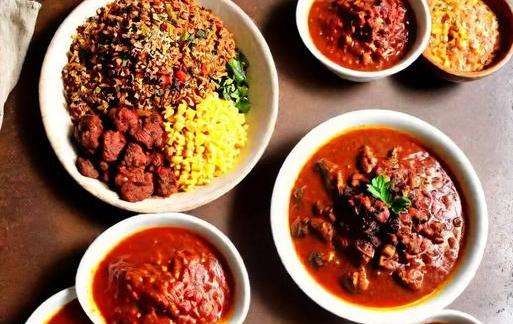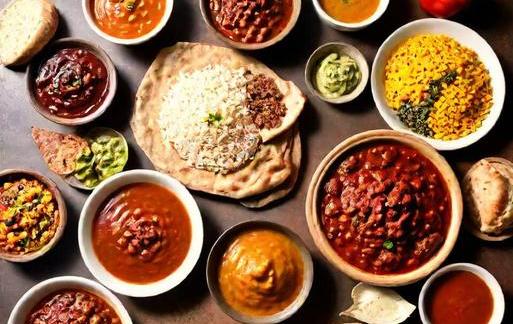- You are here:
- Home »
- Food
- » [REVEALED] African Foods That Start With F
[REVEALED] African Foods That Start With F
Note: This page contains affiliate links.
As an Amazon Associate, I earn from qualifying purchases when you click on the link, but you are not charged extra.
Africa is a vast and diverse continent with a rich tapestry of cultures, languages, and traditions. One of the most captivating aspects of African heritage is its diverse and flavorful cuisine. In this article, we will delve into the culinary world of Africa, specifically focusing on foods that start with the letter "F." From traditional staples to exotic delicacies, African cuisine never fails to surprise and delight the palate. Join us on a gastronomic journey as we explore a list of African foods that start with F, each with its own unique story and cultural significance.
Contents
List Of African Foods That Start With F

1. Fufu
Description: Fufu is a staple in many African countries, known for its versatility and widespread popularity. This dish is made by boiling starchy vegetables like cassava, yams, or plantains and then pounding them into a smooth, elastic dough-like consistency. It is often served as an accompaniment to soups, stews, or sauces.
Cultural Significance: Fufu is more than just a food item; it is a social and cultural experience. In West Africa, it is often eaten communally, with people sharing a common bowl of soup or stew. The act of making and consuming fufu is deeply ingrained in the social fabric of many African communities.
2. Fonio
Description: Fonio is a nutritious grain that has been a staple in West African cuisine for centuries. It is gluten-free, rich in amino acids, and boasts a nutty flavor. Fonio grains are tiny, similar to couscous, and can be used in a variety of dishes, from porridge to salads.
Cultural Significance: Fonio is revered for its resilience and ability to thrive in poor soil conditions. It has been a crucial food source in times of famine and scarcity. The grain holds cultural importance, often being used in traditional ceremonies and celebrations.
3. Fried Plantains
Description: Plantains, a member of the banana family, are a popular ingredient in African cuisine. Fried plantains are a simple yet delicious dish made by slicing ripe plantains and frying them until golden brown. They can be enjoyed as a snack or side dish.
Cultural Significance: Fried plantains are a common street food across Africa. They are loved for their sweet and savory flavor profile and are often paired with spicy sauces or enjoyed alongside grilled meats. This dish is a testament to the continent’s love for bold and contrasting flavors.
4. Ful Medames
Description: Ful Medames, also known as "fava beans," is a hearty and nutritious dish originating from North Africa. The dish consists of cooked fava beans seasoned with olive oil, garlic, and various spices. It is often served with bread, making for a satisfying and wholesome meal.
Cultural Significance: Ful Medames has ancient roots, dating back to Pharaonic Egypt. Today, it remains a popular breakfast dish across the Arab world and North Africa. The preparation and consumption of Ful Medames are steeped in tradition, reflecting the enduring connection to the region’s culinary heritage.
5. Fish Pepper Soup
Description: Fish pepper soup is a spicy and aromatic broth made with a variety of fish, vegetables, and spices. It is a popular dish in West Africa, where different variations exist, incorporating local ingredients and regional flavors.
Cultural Significance: Fish pepper soup is often associated with celebrations and gatherings. It is believed to have medicinal properties and is commonly consumed during the cold season to ward off illnesses. The dish exemplifies the intersection of flavor, tradition, and practicality in African culinary practices.
6. Fatta
Description: Fatta is a traditional Ethiopian dish that combines injera (a sourdough flatbread) with a flavorful sauce made from meat, lentils, and spices. The dish is layered, creating a unique and satisfying texture that captures the essence of Ethiopian cuisine.
Cultural Significance: Fatta is often prepared for special occasions, such as weddings and religious celebrations. It symbolizes abundance and is shared among family and friends, reinforcing the communal aspect of Ethiopian culture. The meticulous preparation of Fatta showcases the culinary expertise passed down through generations.
7. Fufu And Light Soup
Description: Fufu and Light Soup is a classic Ghanaian dish that brings together the beloved fufu and a spicy light soup made with fish or meat. The fufu serves as a perfect accompaniment to the bold flavors of the soup.
Cultural Significance: This dish holds cultural significance in Ghana, where communal dining is highly valued. Fufu and Light Soup are often enjoyed during festive occasions, reflecting the importance of communal celebrations in African societies. The combination of textures and flavors in this dish represents the complexity and depth of African gastronomy.
8. Ful Akhdar
Description: Ful Akhdar, or "green fava beans," is a popular dish in Sudan. The dish involves cooking fava beans with herbs, spices, and sometimes meat, creating a flavorful and wholesome meal.
Cultural Significance: Ful Akhdar is a symbol of simplicity and sustainability. The use of locally available ingredients and the straightforward preparation method make it a practical and nutritious choice for many Sudanese families. The dish embodies the resourcefulness ingrained in African culinary traditions.
African cuisine is a treasure trove of flavors, textures, and cultural nuances. From the comforting embrace of fufu to the spicy allure of fish pepper soup, each dish tells a story of tradition, resilience, and community. The foods highlighted in this article represent just a fraction of the diverse culinary landscape that Africa offers. As we explore African foods that start with the letter "F", it becomes evident that these dishes are not merely sustenance but a celebration of heritage and identity. Whether enjoyed in a bustling market, a family gathering, or a formal ceremony, these foods connect people to their roots and each other. Next time you have the opportunity to savor African cuisine, consider the depth of history and culture infused in each bite. The foods that start with "F" are not just letters on a menu but gateways to a world of culinary artistry that continues to captivate and inspire.
Significance

Africa is a continent known for its rich and diverse culinary heritage, with each region offering a unique array of flavors, spices, and cooking techniques. In this exploration of African foods, we will focus on a specific letter: F. From the bustling markets of West Africa to the spice-infused kitchens of the East, we will delve into a variety of dishes, ingredients, and culinary traditions that start with the letter F.
Understanding the significance of African foods is crucial to appreciating the cultural depth embedded in each dish. Food in Africa is more than sustenance; it is a reflection of history, traditions, and the geographical diversity of the continent. By spotlighting foods that start with F, we aim to celebrate the gastronomic richness that contributes to the vibrant tapestry of African cuisine.
Category-Related

West African Flavors
-
Fufu: A staple in West African cuisine, fufu is a starchy side dish made from pounded cassava, yams, or plantains. It is often served alongside soups, stews, or sauces, acting as a versatile accompaniment to various savory dishes.
-
Feijoada: Originating from Cape Verde, feijoada is a flavorful bean stew that typically includes black beans, pork, and various spices. It is a hearty and comforting dish enjoyed in many West African households.
-
Fried Rice: While not exclusive to Africa, West African fried rice has its own distinct twist. Often featuring local spices, vegetables, and meats, this dish showcases the region’s ability to infuse global favorites with its unique culinary flair.
Ethiopian Delights
-
Fasolia: A popular Ethiopian dish, fasolia is a savory stew made with green beans, tomatoes, and spices. It is often served as a vegetarian option and highlights the country’s love for bold flavors and aromatic seasonings.
-
Fitfit: This dish consists of shredded injera (a sourdough flatbread) mixed with spices, vegetables, and sometimes meat. Fitfit offers a delightful combination of textures and flavors, showcasing the diversity of Ethiopian cuisine.
-
Ful Medames: A beloved breakfast dish, ful medames features slow-cooked fava beans seasoned with olive oil, garlic, and various spices. It is often accompanied by bread, making it a wholesome and nutritious start to the day.
Common Themes
African foods that start with F share common themes that transcend regional boundaries. These themes not only tie the diverse cuisines together but also offer insights into the cultural practices and culinary philosophies that underpin African gastronomy.
Staple Ingredients
-
Fruits: Many African dishes incorporate a variety of indigenous fruits. From the tangy tamarind used in sauces to the sweet and succulent figs added to desserts, fruits play a vital role in balancing flavors.
-
Fish: Given the extensive coastlines surrounding the continent, fish is a ubiquitous ingredient. Whether smoked, grilled, or stewed, fish contributes to the rich tapestry of African culinary traditions.
Bold Spices And Seasonings
-
Fenugreek: Widely used in North African cuisines, fenugreek adds a distinct, slightly bitter flavor to dishes. It is a common spice in stews, bread, and spice blends, offering depth and complexity.
-
Fennel: Found in both North and East African dishes, fennel seeds contribute a sweet, anise-like flavor. They are often used in spice blends, sausages, and pickles, enhancing the overall taste of a dish.
Cultural Celebrations
-
Festivals: Many African dishes that start with F are integral parts of cultural festivals. From the celebratory feasts during harvest festivals to the communal preparation of special dishes, food plays a central role in marking significant occasions.
-
Family and Community Bonding: African meals are often shared among family and friends. The act of coming together to prepare and enjoy food fosters a sense of community and strengthens social bonds.
Interesting Facts
-
Fonio: While not as well-known globally, fonio is a nutritious grain that deserves recognition. Commonly grown in West Africa, fonio is gluten-free, rich in amino acids, and boasts a nutty flavor. It is used in various dishes, such as porridge and salads.
-
Fufu Variations: Fufu, a widespread dish in West Africa, comes in various regional variations. The choice of starchy base, whether cassava, yams, or plantains, can vary, leading to distinct textures and flavors in different fufu preparations.
-
Fermented Foods: Fermentation is a traditional food preservation method across Africa. Fermented foods like fufu and fermented porridges not only have extended shelf life but also offer unique probiotic benefits for digestive health.
Conclusion
Exploring African foods that start with F provides a window into the diverse and dynamic culinary landscape of the continent. From the comforting stews of West Africa to the spice-infused delights of Ethiopia, each dish tells a story of tradition, innovation, and cultural richness. As we celebrate these flavors, let us recognize the significance of African cuisine in shaping the identity and heritage of the continent. Embracing the culinary diversity of Africa is not just an exploration of taste but a journey into the heart of vibrant cultures and centuries-old traditions.


